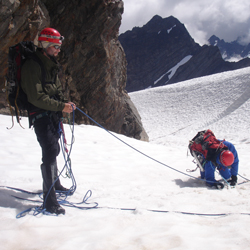 |
 | |
  | |
|
|
|
|
Olympic National Park
Climbing Mount Olympus
|
|
|
|
|
| |
 |
|
Notices
-
Groups of more than 6 are required to camp in designated "Group Camps". Stock parties are required to camp in designated "Stock Sites". are recommended for these sites.
-
Contact the WIC for information about trailhead shuttles. (360) 565-3100
|
|
Description
Ecosystem type: Glacier
Trail tread types: none
General elevation trend: flat to steep
Level of difficulty: Moderate to difficult
Distance: 4-6 miles from Glacier Meadows to Summit.
Elevation change: 4,400 ft. to 7,980 ft.
Best Season: Late June through mid-August
|
|
Camping
Permits/Reservations: Wilderness Camping Permits are required for all overnight trips. Obtain permits in person at the WIC in Port Angeles or at the Hoh Visitor Center. Reservations should be made for parties of 7 or more persons and for groups with stock animals. All other sites are first come, first served. Reservations can also be made for Elk Lake, Glacier Meadows, Hoh Lake and the 7 Lakes Basin Area. Reservations may be made by calling the WIC at (360) 565-3100.
Food Storage Method: Bear canisters are required for camping beyond Glacier Meadows on Mt. Olympus. Community bear wires are available at Tom Creek, Happy Four, 5-mile Island, Olympus Guard Station, Lewis Meadow, Elk Lake and Glacier Meadows.
Location and sites: Camp areas are located at Caltech Rocks and Snow Dome. No camping between Glacier Meadows and the Blue Glacier. See also for lower camps.
Toilet Facilities: Pit toilets at 5-mile Island, Olympus Guard Station, Elk Lake, Glacier Meadows. Blue bags required on Mt. Olympus; use the blue bag receptacle on the lateral moraine to deposit used blue bags.
Water Source: Glacier
|
|
Special Concerns
Leave No Trace: Leave No Trace of your stay to protect vegetation and prevent further camping regulations.
Campfires: No campfires above Martin Creek to protect sensitive vegetation. Please use dead and down wood and leave no trace of your fire when you leave.
Respect Wildlife: To protect bears and other wildlife, all food, garbage and scented items must be stored in bear canisters if you are camping above Glacier Meadows.
|
|
Safety
In early season several steep snow slopes exist along this trail. An ice axe and crampons may be required for much of the spring and early summer. It may also be difficult to follow sections of trail due to snow. Map and compass skills may also be required during winter, spring and early summer.
During Winter months, travel above Elk Lake is not recommended due to steep avalanche chutes. Ropes and anchors may be necessary to cross these safety.
Climbing Mt. Olympus should only be attempted by experienced mountaineers who have glacier travel and crevasse rescue skills and gear.
|

|
| Ian Stacy |
| Climbers on the Blue Glacier |
|

|
| Ian Stacy |
| Glacier Staircase |
|

|
| AJ Lange |
| Successful Climbers descending from the Summit of Mt. Olympus |
|
|
|
|

Need Maps?
Click here to order park maps and guidebooks
more... | | 
Weather Conditions
Current conditions from around the park.
more... | | 
Weather Forecasts
Get the latest local weather forecasts
more... | | 
Avalanche!
Avalanches are a real risk; learn how to avoid them.
more... | |
|
|
|
|
|
|
|
 |
|
Did You Know?
That endemic Olympic snow moles are scurrying beneath this blanket of snow? Olympic National Park's Hurricane Ridge is blanketed with over ten feet of snow for most of the winter, providing water for summer and protection for snow moles in winter.
|
|
|
|
Last Updated: January 12, 2008 at 16:50 EST |






